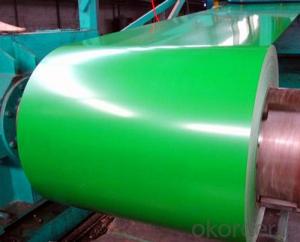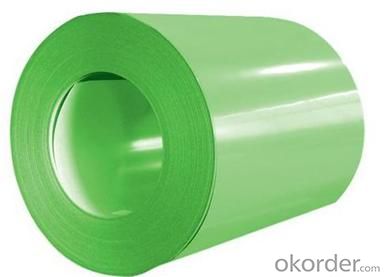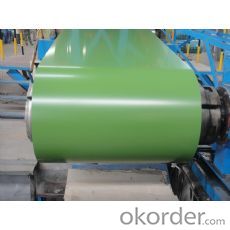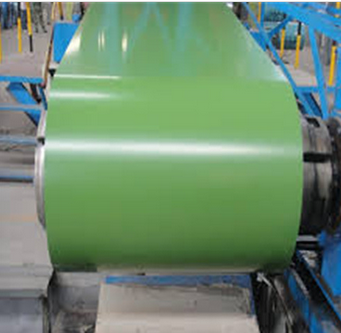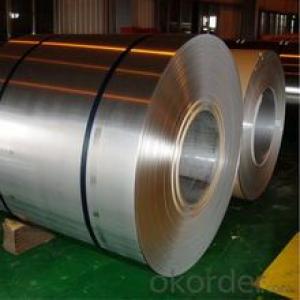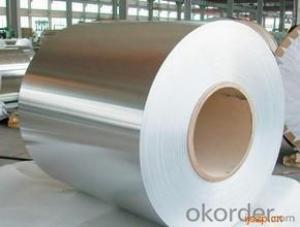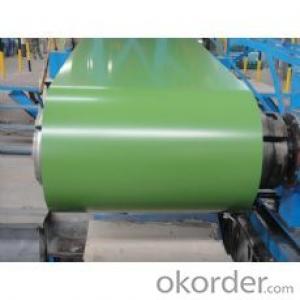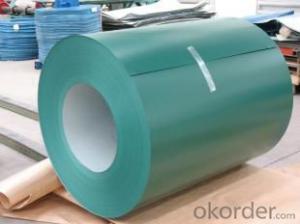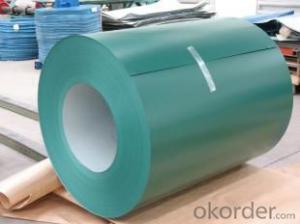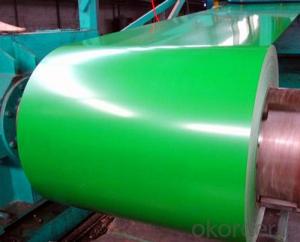PPGI,Pre-Painted Steel Coil/Sheet Prime Quality Green Color
- Loading Port:
- Shanghai
- Payment Terms:
- TT OR LC
- Min Order Qty:
- 200 m.t.
- Supply Capability:
- 10000 m.t./month
OKorder Service Pledge
OKorder Financial Service
You Might Also Like
1. Pre-Painted Galvanized/Aluzinc Steel Coil Description:
With GI as base material, after pretreatment (degrease and chemical treatment ) and liquid dope with several layers of color, then after firing and cooling, finally the plate steel is called pre-painted galvanized (aluzinc) steel. Pre-painted galvanized steel is good capable of decoration, molding, corrosion resistance. It generally displays superior workability, durability and weather resistance.
2.Main Features of the Pre-Painted Galvanized/Aluzinc Steel Coil:
• Excellent process capability
• Smooth and flat surface
• Workability, durability
• Excellent heat resistance performance
• High strength
• Good formability
• Good visual effect
3.Pre-Painted Galvanized/Aluzinc Steel Coil Images
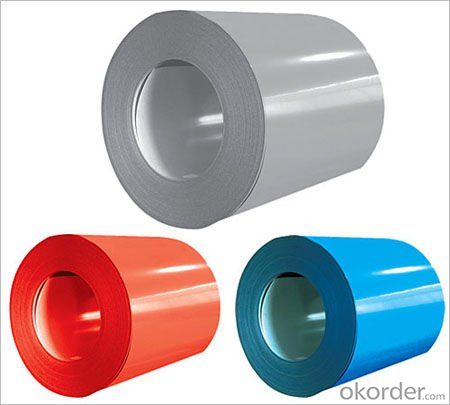
4.Pre-Painted Galvanized/Aluzinc Steel Coil Specification
Standard: AISI, ASTM, BS, DIN, GB, JIS
Grade: DX51D, DX52D
Thickness: 0.17-2.0mm
Brand Name: KMRLON
Model Number: coil
Type: Steel Coil
Technique: Cold Rolled
Surface Treatment: Coated
Application: Boiler Plate
Special Use: High-strength Steel Plate
Width: 20-1250mm
Length: customized
commoidty: pre-painted galvanized steel coil
Thickness: 0.13-4.0mm
width: 20-1250mm
zinc coating: 40-180g/m2
printing thickness: top side: 20+/-5 microns, back side: 5-7 microns
color: all RAL color
surface treatment: color coated
coil weight: 4-7 tons
coil ID: 508/610mm
packaging: standard seaworthy packing
5.FAQ of Pre-Painted Galvanized/Aluzinc Steel Coil
1. What’s the application of this product?
Roof, roof structure, surface sheet of balcony, frame of window, etc.
2. What’s the brand of the paint?
We use the best brand of all of the word—AKZO.
3. How to guarantee the quality of the products?
We have established the international advanced quality management system,every link from raw material to final product we have strict quality test;We resolutely put an end to unqualified products flowing into the market. At the same time, we will provide necessary follow-up service assurance.
4. How long can we receive the product after purchase?
Usually within thirty working days after receiving buyer’s advance payment or LC. We will arrange the factory manufacturing as soon as possible. The cargo readiness usually takes 15-25 days, but the shipment will depend on the vessel situation.
- Q: What are the different types of steel coil packaging machines?
- There exists a variety of steel coil packaging machines in the market, each serving a specific purpose. These machines are designed to package steel coils efficiently and effectively for storage, transportation, or distribution. Some of the available types of steel coil packaging machines are as follows: 1. Fully automated steel coil packaging machine: This machine is equipped with advanced technology and can handle large-scale packaging requirements. It wraps the steel coils with a protective layer of film or paper and can also apply strapping or stretch film to secure the coils during transportation. 2. Semi-automated steel coil packaging machine: This machine requires some manual intervention for loading and unloading the steel coils. It is suitable for medium to high-volume packaging needs and strikes a good balance between automation and cost-effectiveness. The machine typically employs a combination of wrapping, strapping, and shrinking techniques to package the coils. 3. Steel coil packaging machine with a vertical design: This machine is specifically designed for packaging vertical steel coils. It wraps the coils with a layer of film or paper and then applies strapping or stretch film to secure them. The vertical design facilitates easy loading and unloading of the coils. 4. Steel coil packaging machine with a horizontal design: This machine is ideal for packaging horizontal steel coils. It wraps the coils with a protective layer of film or paper and then applies strapping or stretch film to secure them. The horizontal design ensures convenient loading and unloading of the coils. 5. Customized steel coil packaging machine: Certain manufacturers offer customized packaging solutions tailored to specific requirements. These machines can be adjusted to accommodate different coil sizes, shapes, and packaging materials. They are designed to provide utmost flexibility and efficiency in the packaging process. To summarize, the different types of steel coil packaging machines encompass fully automated, semi-automated, vertical, horizontal, and customized machines. The selection of a suitable machine depends on factors such as packaging volume, coil orientation, and specific requirements of the steel coils being packaged.
- Q: What are the dimensions of steel coils used in the storage tank industry?
- Steel coils used in the storage tank industry come in various dimensions, depending on the specific requirements of the tank being manufactured. Generally, these coils are available in different sizes and thicknesses. The width of the steel coils can range from approximately 600 millimeters to 2,400 millimeters. Similarly, the length can vary from a few meters to tens of meters. The thickness of the coils can also differ, typically ranging from 1.5 millimeters to 10 millimeters or more. Factors such as the size and capacity of the storage tank, the material being stored, and the structural requirements of the tank determine these dimensions. Consequently, the tank manufacturer or designer would determine the specific dimensions for a given storage tank project, following industry standards and project specifications.
- Q: What are the different methods of coil recoiling for steel coils?
- There are several different methods of coil recoiling for steel coils, each with its own advantages and applications. Some of the common methods include: 1. Slitting and rewinding: This method involves cutting the wide steel coil into narrower strips, which are then rewound into smaller coils. Slitting machines with circular blades are typically used to cut the steel, and the rewinding process ensures tight and uniform winding of the narrower strips. This method is widely used in industries such as automotive, construction, and packaging. 2. Rewinding with tension control: In this method, the steel coil is unwound and rewound with the help of tension control systems. These systems maintain even tension throughout the recoiling process, ensuring consistent winding quality. This method is particularly useful when dealing with delicate or sensitive materials that require gentle handling. 3. Recoiling with edge trimming: Sometimes, the edges of steel coils may be damaged, uneven, or contain defects. In such cases, edge trimming can be employed along with the recoiling process. Edge trimming machines remove the defective sections, resulting in coils with smooth and consistent edges. 4. Recoiling with surface treatment: Surface treatment methods like oiling, coating, or galvanizing are often applied to steel coils to enhance their corrosion resistance or improve their surface properties. Recoiling can be done in conjunction with these treatments, ensuring proper application and uniform coverage on the entire coil surface. 5. Recoiling with tension leveling: Tension leveling is a process that helps eliminate coil shape defects, such as coil set or crossbow, by applying tension during recoiling. This method ensures that the final coil has a flat and even shape, which is beneficial for subsequent processing and manufacturing operations. 6. Recoiling with precision slitting: Precision slitting is a specialized method used to achieve extremely narrow strip widths or tight tolerances in the steel coil. It involves precise control of the slitting knives and the winding tension to ensure accurate and consistent strip dimensions. This method is commonly used in industries that require high precision, such as electronics or precision engineering. Overall, the choice of coil recoiling method depends on various factors including the desired coil dimensions, material characteristics, surface requirements, and the specific application or industry involved. Manufacturers often utilize a combination of these methods to meet the diverse needs of their customers.
- Q: hey i was looking to buy a khukuri machete by cas iberia. its made of carbon steel but doesnt say which one. anyone that is into knives and all that know how this would hold up and the rust resistance of it? mostly be used for cutting bush and small trees
- There's no way to tell from the information you posted. Given it's for a machete I would guess it would be a fairly high carbon steel. Rust resistance will be relatively poor. It will last for years though as long as you clean and dry it after use.
- Q: What are the common problems faced during steel coil production?
- During the production of steel coils, several common issues may arise. One of the most frequently encountered problems is the breakage or damage of the coils. This can happen as a result of improper handling or transportation, leading to cracks or fractures. To minimize the risk of coil breakage, it is crucial to adhere to proper handling procedures. Another issue that often arises is coil slippage. This occurs when the coils are not securely stacked or stored, causing them to shift or slide. Coil slippage can cause damage to the coils and potentially lead to accidents or injuries. Therefore, it is essential to have adequate storage systems in place to prevent such slippage. Furthermore, corrosion is a prevalent problem in steel coil production. Corrosion can be caused by exposure to moisture, air, or other corrosive substances. It can result in the deterioration of the steel, reducing its strength and durability. To address this issue, it is necessary to implement effective corrosion prevention measures, such as proper coating or storage techniques. Coil quality issues are another challenge faced in steel coil production. These problems can include inconsistencies in thickness, width, or surface defects on the coils. Various factors, such as improper rolling processes, equipment malfunctions, or material defects, can contribute to these quality problems. Regular quality checks and inspections should be carried out to promptly identify and resolve any issues. Moreover, problems related to coil handling and loading may also arise during steel coil production. Improper lifting or loading techniques can lead to coil damage, resulting in deformations or even accidents. Proper training and education of employees on appropriate handling and loading procedures are crucial to prevent such problems. In conclusion, steel coil production can encounter various challenges, ranging from coil breakage and slippage to corrosion and quality issues. Implementing proper handling, storage, and quality control measures is indispensable in minimizing these problems and ensuring the production of high-quality steel coils.
- Q: Can steel coils be coated with ceramic?
- Yes, steel coils can be coated with ceramic. This coating provides several benefits such as increased corrosion resistance, improved heat resistance, and enhanced durability. Additionally, ceramic coating can also provide an aesthetic appeal to the steel coils.
- Q: will peircers use surgical steel? how do you know for sure what they are using?
- DO NOT USE SURGICAL STEEL. Use IMPLANT GRADE stainless steel, or, even better, IMPLANT GRADE titanium. surgical steel is a marketing term, pioneered by a cutlery company to make their cutlery seem cleaner. So basically, surgical steel can be anything from the forks and knives in your house, to the rusty tools in the shed, whilst implant grade stainless steel is specifically made for medical uses in the body (pins in your foot or a pacemaker in your heart.)
- Q: Which one would be stronger? And should damascus steel be tempered?Thank You
- Damascus steel is in history books only,no body knows its composition.THey just named a modern steel as Damascus steel
- Q: If i get a samurai sword made of carbon steel, what is the hardest thing i can hit before it breaks? Or will it not break?
- Real katanas need regular maintenance, they rust easily and dull quickly. If you get a replica chances are it will break the first time you hit anything with it. If you can find one, the WW2 officers swords were of good quality and the modern metals mean it doesn't rust or dull as easily. If you do insist on getting a carbon steal blade be ready to oil it often. It will rust at the mention of moisture.
- Q: Which is used for what?Differences as far as style etc.???Better in your opinion and why??I'm just beginning to look at guitars i might be able to get at christmas if i'm still committed..i've been looking online.,,,,NYLON or STEEL STRINGED ACOUSTIC GUITAR????Thanks.
- u can play any type o music with steel stringed guitar.. but with nylon string ,guitarist usually pick the strings with finger nails,coz its will be hard to hit that with guitar picks coz there will be a chance of string popping nylon string gutiars are used for classical guitar playing... the tone is somehow sweeter on nylon.. but its up to you according to your music style
Send your message to us
PPGI,Pre-Painted Steel Coil/Sheet Prime Quality Green Color
- Loading Port:
- Shanghai
- Payment Terms:
- TT OR LC
- Min Order Qty:
- 200 m.t.
- Supply Capability:
- 10000 m.t./month
OKorder Service Pledge
OKorder Financial Service
Similar products
Hot products
Hot Searches
Related keywords
